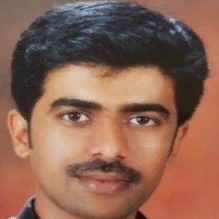
Shreekanth.T
Work place: JSS Research Foundation, Mysore, India
E-mail: speak2shree@gmail.com
Website:
Research Interests: Speech Synthesis, Speech Recognition, Image Processing, Image Manipulation, Image Compression
Biography
Shreekanth. T completed his Bachelor of Engineering in Electronics and Communication from PES College of Engineering, Mandya, affiliated to Visvesvaraya Technological University, Belgaum, Karnataka, and obtained his master's degree in the area of BioMedical Signal Processing from Sri Jayachamarajendra College of Engineering, Mysore affiliated to Visvesvaraya Technological University, Belgaum, Karnataka. Currently he is pursuing PhD in the area of Image and Speech signal processing. His areas of interest include Digital Image Processing and Speech Signal Processing. He has to his credit 15 conference and Journal papers both at national and international level. Presently he is working as an Assistant Professor in the department of Electronics and Communication at Sri Jayachamarajendra College of Engineering, Mysore, Karnataka, India.
Author Articles
Automated Quality Inspection of PCB Assembly Using Image Processing
By Punith Kumar M B Shreekanth.T Prajwal M R
DOI: https://doi.org/10.5815/ijigsp.2020.03.02, Pub. Date: 8 Jun. 2020
Quality inspection of PCB is a crucial stage in the assembly line as it provides an insight on whether the board works correctly or not. When the inspection is done manually, it is susceptible to human errors and is time consuming. The boards should thus be inspected at every stage of the assembly line and the process should be dynamic. This is achieved in this work through three crucial stages in the assembly line and by replacing the conventional manual inspection by using image processing to obtain a faster and more precise quality inspection. The solder paste inspection consists of pre-processing using blue plane conversion, comparing with the unsoldered board in blue color plane and post processing using overlay. The X-ray inspection basically consists of pre- processing the captured image by RGB to gray conversion with thresholding, comparing with the expected image and post processing using overlay to show the shorts that has occurred along the assembly. The conformal coating inspection uses conversion of the blue intensity emitted off the board under UV light to RGB scale. Each of the algorithms were tested using 48 actual in-production boards from Vinyas IT Pvt Ltd, a PCB assembly company based in Mysore. The processing time of the algorithms were found to be less than 2 seconds with an accuracy of 85.7%. The system was also found to be cost effective over existing systems available in the market.
[...] Read more.A New Research Resource for Optical Recognition of Embossed and Hand-Punched Hindi Devanagari Braille Characters: Bharati Braille Bank
By Shreekanth.T V.Udayashankara
DOI: https://doi.org/10.5815/ijigsp.2015.06.03, Pub. Date: 8 May 2015
To develop a Braille recognition system, it is required to have the stored images of Braille sheets. This paper describes a method and also the challenges of building the corpora for Hindi Devanagari Braille. A few Braille databases and commercial software's are obtainable for English and Arabic Braille languages, but none for Indian Braille which is popularly known as Bharathi Braille. However, the size and scope of the English and Arabic Braille language databases are limited. Researchers frequently develop and self-evaluate their algorithm based on the same private data set and report its behavior using ad-hoc measures of performance. There is no well-defined benchmark database for comparative performance evaluation of results obtained. The developed Braille database, Bharati Braille-Bank, is a large and well characterized information of Braille documents and its related data for use by the research community working in Optical Braille Recognition (OBR) for Bharati Braille. In the present form it includes databases of embossed double sided, embossed single sided, skewed, Hand punched and images with varying resolutions of Hindi Braille. The objective of this work is to stimulate current research and new investigations in the study of Hindi OBR. Without common databases such as those provided by Braille Bank it is impossible to resolve certain contradictory research results. To overcome this problem, Braille Bank provides facilities for the comparative analysis of the data and the evaluation of proposed algorithms with the standard database. In addition, it provides free access to the developed database in the form of Compact Disc-Read Only Memory (CD-ROM). This work is a step forward in the direction of development of standards for Hindi Devanagari Braille data collection for Indian languages. The mission of the resource is to accelerate the development of OBR for Bharati Braille.
[...] Read more.Other Articles
Subscribe to receive issue release notifications and newsletters from MECS Press journals